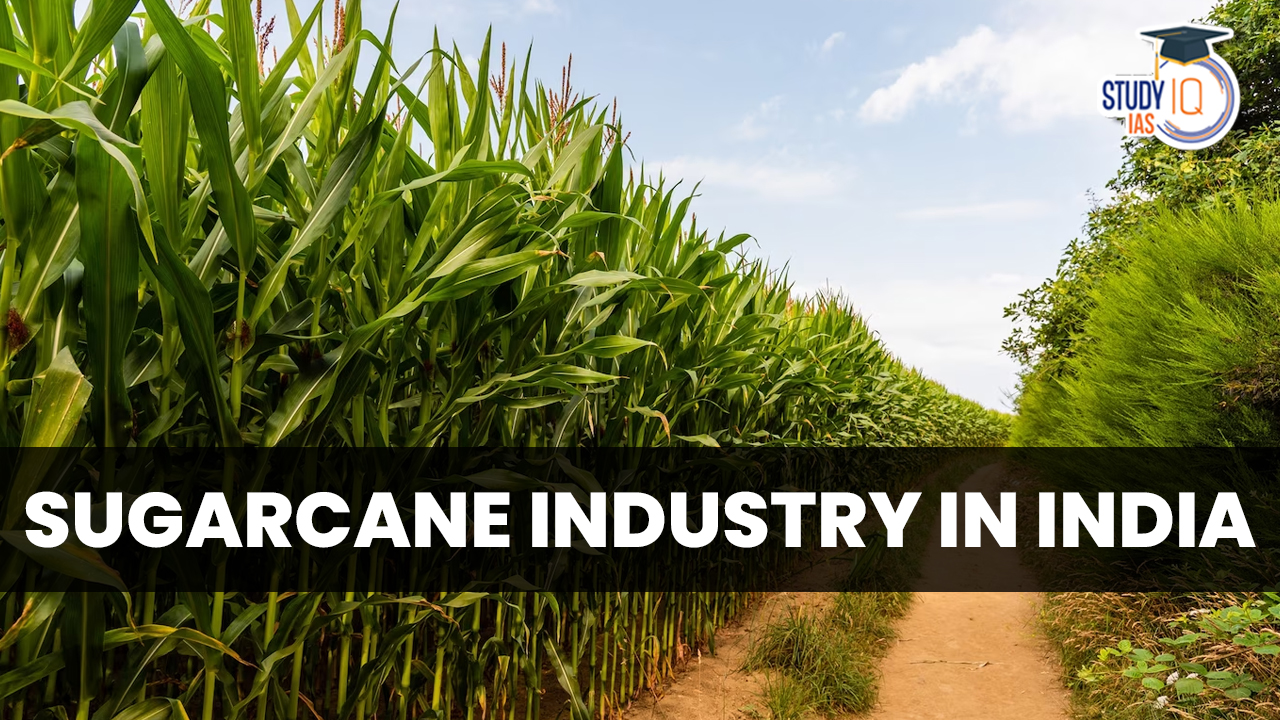Table of Contents
Context: It has been observed that the extensive use of resources in sugar production is depleting rapidly in India, leading to a potential crisis in the future.
More on News
- India became the world’s top sugar producer in 2021-2022, surpassing Brazil with a record of 359 lakh tonnes.
- The sugar surplus and high exports are a result of policies favouring sugarcane cultivation, such as the fair and remunerative price (FRP) scheme and State government subsidies.
- However, the extensive use of resources in sugar production is depleting rapidly, leading to a potential crisis in the future.
- Also, as India’s top sugarcane-growing states rely heavily on groundwater for irrigation, it has led to concerns over groundwater depletion and associated challenges.
Reasons for excess sugar production
- Fair and Remunerative Price (FRP) scheme: The Central government offers a minimum price guarantee to sugar mills for sugarcane, known as the Fair and Remunerative Price (FRP). This scheme ensures that sugarcane farmers receive fair profits for their crop, encouraging them to cultivate more sugarcane.
- State government subsidies: Many state governments in India provide heavy subsidies to incentivize sugarcane cultivation. These subsidies can include financial support, agricultural inputs etc that make sugarcane farming more attractive to farmers.
- Political considerations: In regions with significant rural populations, farmers’ votes can play a crucial role in elections. To secure support from rural areas, governments may adopt policies that favour sugarcane cultivation, even if it leads to excess production.
- Meeting domestic demand: India is the world’s largest consumer of sugar, and the demand for sugar is high due to its widespread use in the food and beverage industry. To meet this domestic demand, the country has been promoting higher sugarcane production.
- Export opportunities: With the surplus sugar production, India has been able to export significant quantities of sugar to other countries. The lucrative export market provides an incentive for increased production.
Advantages of Increased Sugar Production
- Economic Growth: Increased sugar production contributes to the economy through exports, employment generation, and agro-industrial activities.
- Foreign Exchange: Sugar exports bring in foreign exchange, helping stabilize trade balances.
- Rural Livelihoods: The sugar industry supports the livelihoods of millions of farmers and workers in rural areas.
- Supply Chain: The sugar industry has a significant supply chain involving transportation, processing, and distribution, providing economic opportunities.
Concerns Raised
The excessive production and subsidization have raised concerns among other sugar-producing countries.
- Countries like Brazil, Australia, and Guatemala filed a complaint with the World Trade Organization (WTO) against India, accusing it of violating international trade rules by offering excessive export subsidies and domestic support to farmers.
Efforts to Address the Issue
To address the sugar surplus issue, the government has taken several measures that aim to reduce crude oil imports, curtail greenhouse gas emissions, and promote the use of renewable fuels in the transport sector.
- Ethanol Blended Petrol (EBP) Programme: The government launched the EBP programme in 2003 to promote the blending of ethanol with petrol. Initially, the program aimed to achieve a blending rate of 5%. However, the target set for 2025 is a blending rate of 20%. This program encourages the use of ethanol as a biofuel and reduces the reliance on fossil fuels.
- Incentives for Ethanol Production: The government has provided incentives and support to encourage the diversion of excess sugar towards ethanol production. One significant measure was reducing the Goods and Services Tax (GST) on ethanol from 18% to 5% in 2021. This tax reduction makes ethanol production more economically viable and attractive for producers.
- Diversion of Sugar to Ethanol: As part of the efforts to address the sugar surplus, the government has actively encouraged the diversion of excess sugar towards ethanol production.
- In 2021, out of the total 394 lakh tonnes of sugar produced, about 350 lakh tonnes were diverted to produce ethanol.
- This diversion helped reduce the sugar surplus while promoting the production of a more sustainable and eco-friendly fuel.
- Achieving Blending Targets Ahead of Schedule: India achieved a blending rate of 10% months ahead of the target set for the EBP programme. This achievement demonstrates the success of the government’s efforts to increase the usage of ethanol-blended petrol in the transport sector.
- Focus on Environmental Benefits: Ethanol is known for its ability to reduce harmful emissions from petrol-based vehicles, such as carbon monoxide and various hydrocarbons. By promoting ethanol-blended petrol, the government aims to curtail greenhouse gas emissions and improve air quality, contributing to environmental protection.
Excess Sugarcane Cultivation and Groundwater Depletion
Ways in which excessive sugarcane cultivation impacts groundwater:
- High water requirements: Sugarcane is a water-intensive crop and requires a substantial amount of water for its growth and development. In regions with inadequate rainfall, farmers heavily rely on groundwater for irrigation, leading to increased extraction from aquifers.
- Depletion of confined aquifers: Many regions that cultivate sugarcane rely on confined aquifers as a source of groundwater. These aquifers are limited and cannot recharge as quickly as water is being extracted. Continuous over-extraction can lead to the depletion of these confined aquifers, causing long-term consequences for water availability.
- Groundwater stress: When water is withdrawn from aquifers at a rate faster than it can naturally recharge, the groundwater table drops, leading to groundwater stress. This can impact not only agriculture but also domestic water supply for local communities.
- Drought-prone regions: Some areas where sugarcane is grown are already prone to droughts, and the high water demand of sugarcane exacerbates the situation. Excessive extraction of groundwater resources can deplete these reserves, making the region more vulnerable to drought conditions.
- Environmental impact: Lowering the groundwater table can lead to the drying up of wells, rivers, and wetlands, impacting the natural habitat and biodiversity of the area.
- Subsidence: Over-extraction of groundwater can also lead to land subsidence, where the land surface sinks due to the collapse of aquifer layers. This subsidence can cause structural damage to buildings and infrastructure.
Potential Solutions to the Problem
- While, surplus production and export have enormous financial gain, amounting to lakhs or crores of rupees a year, the environmental implications of excess sugar production should be clear.
- A better and more sustainable way would be to assess and then correct incentives that skew in favour of sugarcane over other crops, leading to a consistent surplus.
- Introducing fair and comprehensive subsidy schemes for a variety of crops can help farmers diversify as well as distribute cultivation evenly, prevent monocultures, and ensure an equitable income.
- The availability of a wider range of profitable and less resource-intensive crops can lower the strain on vital natural resources.
- This must be complemented by environmentally responsible sugarcane cultivation practices that prioritise groundwater, such as drip irrigation, to tackle the issue in the long run.
- In drip irrigation, water is allowed to drip slowly but directly to the roots of sugarcane plants, reducing water consumption by up to 70% relative to the current flood irrigation method.
- This method has already been made mandatory in many parts of India, and the government has also offered subsidies to farmers for setting up the system.
- Next, India needs to invest in overall water-saving and management systems.
- Concerted efforts to adopt cleaner practices such as rainwater harvesting, wastewater treatment, and canal irrigation networks, will help minimise stress on groundwater reservoirs as other water sources become available for irrigation.
- Installing solar panels on sugarcane fields is one such approach.
- Solar panels can provide shade for the crops, reducing water evaporation from the soil and mitigating the water demand.
- Although the CGWB conducts significant research and generates valuable data, many aspects of groundwater availability and distribution remain poorly understood and/or mapped. Investment in groundwater research, therefore, needs to be considered seriously.
Status of India’s Sugarcane Sector
- Sugar industry is an important agro-based industry that impacts the rural livelihood of about 50 million sugarcane farmers and around 5 lakh workers directly employed in sugar mills.
- It is the second largest agro-based industry in India after cotton.
- Geographical Conditions for the Growth of Sugar:
- Temperature: Between 21-27°C with hot and humid climate.
- Rainfall: Around 75-100 cm.
- Soil Type: Deep rich loamy soil.
- Top Sugarcane Producing States: Maharashtra>Uttar Pradesh > Karnataka
- Status of Sugarcane Sector:
- India is the world’s top Producer, User, and Second-largest Exporter of sugar.
- According to the Indian Sugar Mills Association (ISMA), the sugar production of India rose by 3.69% to 12.07 million tonnes during the October-December quarter of 2022.
- In the same period last year, it stood at 11.64 million tonnes.
- Total sugar production, after diversion for ethanol manufacturing, has increased to 193.5 lakh tonnes till January 2023 from 187.1 lakh tonnes in the year-ago period.
Challenges Associated with Growing Sugarcane
- Time and Labour Intensive: Sugarcane has a long growth cycle, demanding sustained efforts over about three years. The labour-intensive process includes planting, nurturing, and harvesting.
- Higher Investment: Preparing fields, purchasing seedlings, and providing fertilizers entail substantial costs for farmers.
- Water Usage and Environmental Impact: Sugarcane cultivation requires significant water resources, which can lead to over-extraction of groundwater and environmental issues in water-scarce regions.
- Monoculture and Soil Health: Overemphasis on sugarcane can lead to monoculture, depleting soil nutrients and increasing susceptibility to pests and diseases.
- Market Challenges: High domestic production can lead to market saturation and reduced profitability for both farmers and the industry.
- Export Viability: The cost of producing sugar in India, driven by high sugarcane costs, can make sugar exports less competitive on the international market.
- Dependency on Monsoons: Sugarcane cultivation is heavily reliant on monsoon rainfall, making it vulnerable to climate variability and changing weather patterns.
- Ethical and Labour Issues: The labour-intensive nature of sugarcane farming, including harvesting, can raise concerns about fair wages and working conditions.
- Policy Uncertainties: Trade disputes and policy changes, such as export subsidies and international agreements, can impact the viability of the sector.


 National Technology Readiness Assessment...
National Technology Readiness Assessment...
 Justice Mission-2025: China’s Live-Fir...
Justice Mission-2025: China’s Live-Fir...
 Suryastra: First Made-in-India Long-Rang...
Suryastra: First Made-in-India Long-Rang...

























